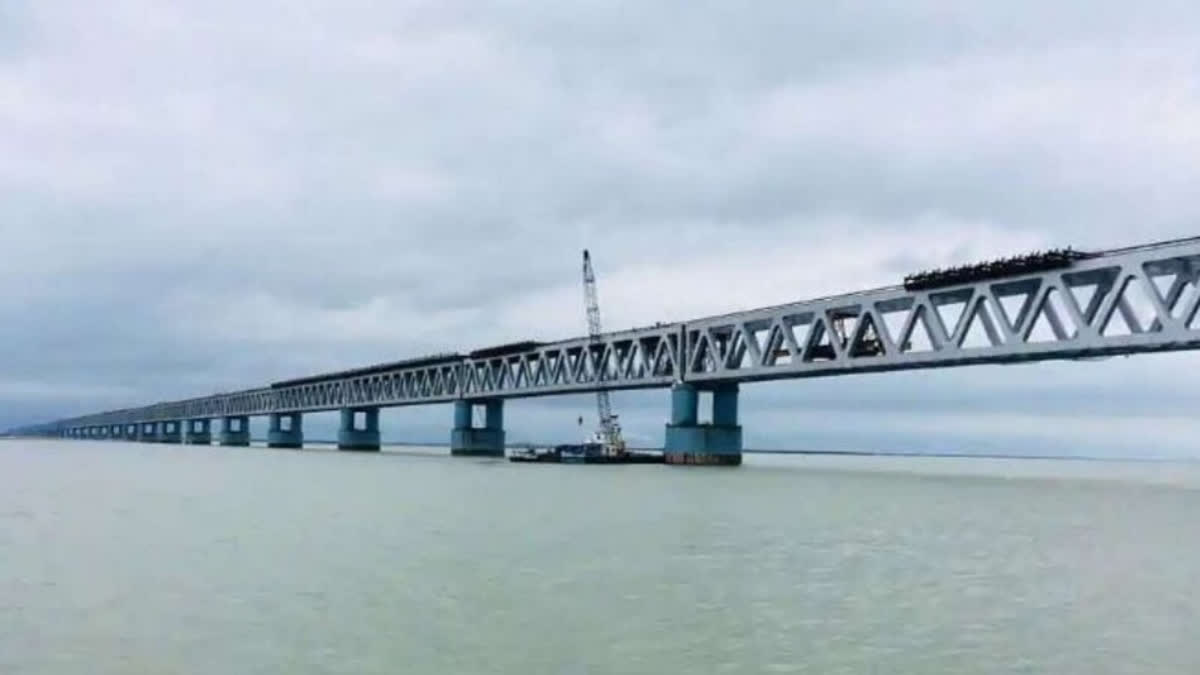New Delhi: With the Maitri Setu, which denotes friendship bridge in native parlance, over river Feni, connecting Sabroom in Tripura with Chittagong port in Bangladesh, set to become operational from the beginning of September, India’s counter-balancing of China’s Belt and Road Initiative (BRI) in terms of regional connectivity will get a leg-up.
At a meeting with tribal leaders last week, Tripura Chief Minister Manik Saha said that once the bridge is opened for the public, Tripura’s third integrated check-post at Sabroom will also commence operations. The construction of the 1.9-km-long bridge, which began in March 2021, will be officially opened for traffic by Prime Minister Narendra Modi virtually during his Bangladeshi counterpart Sheikh Hasina’s visit to New Delhi next month.
Chittagong port is just around 80 km away from Tripura's last border town Sabroom and can be covered by road in two-and-a-half hours. The opening of Maitri Setu will further boost connectivity with India’s strategic northeastern region.
According to South Tripura District Magistrate Saju Vaheed A, the bridge will be initially opened for passenger movement only. Once the system becomes stabilised and infrastructure is fully set up, the movement of goods and cargo would also start. With the opening of this bridge, Tripura will become a gateway to India’s northeastern region and Southeast Asia.
“The Maitri Setu connects the southernmost tip of Tripura with the Chittagong port in Bangladesh,” Sabyasachi Dutta, executive director of the Shillong-based think tank Asian Confluence, told ETV Bharat.
“It will also connect to the Matarbari deep sea port in Bangladesh that is under construction with Japanese aid. With the opening of this bridge, apart from India’s northeastern region, other landlocked countries in the region like Bhutan and Nepal will now get access to the Bay of Bengal.”
Dutta said that the importance of this bridge should be seen from the perspective of the development of the Indo-Pacific region. “Connectivity is vital for the development of every country in the Indo-Pacific region,” he said. The Maitri Setu is but another project to boost connectivity in the Northeast and neighbouring countries, including Myanmar and Bangladesh in the face of Chinese influence in the region. Beijing has already gained a backdoor entry to the Indian Ocean by investing in the Kyaukpyu port in Myanmar’s Rakhine state. Other Chinese infrastructure projects in the region under the BRI include the construction of the Hambantota port in Sri Lanka and the building of an airport in the tourist city of Pokhara in Nepal.
In May this year, the Sittwe port, also in the Rakhine state of Myanmar, which was constructed by India was inaugurated. The port connects with Mizoram in northeastern India via the Kaladan Multimodal Transit Transport Corridor, the construction of which is close to completion.
The Kaladan Multimodal Transport Corridor is not confined to connecting Mizoram to Myanmar but it also encompasses India’s expanded outreach to the prosperous Southeast Asian economies. Additionally, India, being a member of the BIMSTEC (Bay of Bengal Initiative for Multi-Sectoral Technical and Economic Cooperation), the new connectivity routes would help India deepen its presence and ties with the prosperous Southeast Asian countries.
Access to the Bay of Bengal will also substantially bring down freight transportation costs to the Northeast. As of now, the only option for freight transportation between the Northeast and the rest of India is through the Siliguri Corridor, popularly known as the Chicken’s Neck.
With the chain of ports along India’s eastern coast, Indian naval ships can now freely ply in the Bay of Bengal, which is at the centre of the Indo-Pacific region. This will help deter the presence of Chinese naval ships in these waters.
In terms of land connectivity, India is also constructing the India-Myanmar-Thailand Trilateral Highway. The Highway connects Moreh in Manipur with Mae Sot in Thailand via Mandalay, Naypyitaw and Bago in Myanmar.
In terms of sub-regional connectivity, India is a party to the Bangladesh-Bhutan-India-Nepal (BBIN) Motor Vehicle Agreement. The Agreement was conceived after the South Asian Association for Regional Cooperation (SAARC) failed to agree on a regional motor vehicles agreement at a summit in Nepal in 2014, mainly because of opposition from Pakistan. India, Bangladesh and Bhutan have signed the agreement. Bhutan, though, has temporarily opted out pending parliamentary approval.
Operationalising the MVA by concluding the Passenger and the Cargo Protocol will help realise the full potential of trade and people-to-people connectivity between the BBIN countries by fostering greater sub-regional cooperation. The Asian Development Bank has supported the project as part of its South Asian Subregional Economic Cooperation Programme and has been requested to prioritise about 30 road projects worth billions of dollars. Connectivity, they say, is the key to development. Connectivity also is the key to regional security.


